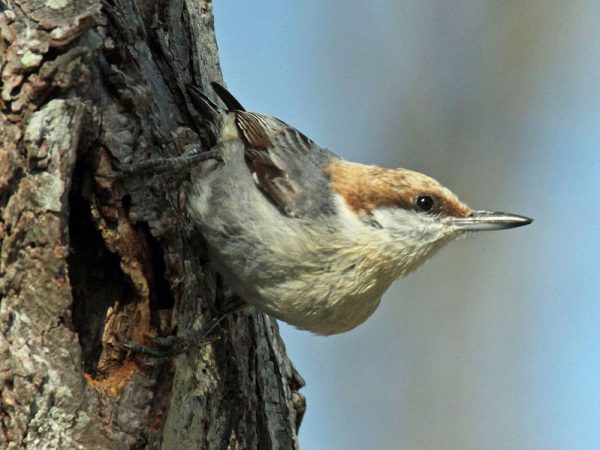Nest boxes for nuthatches

The brown-headed nuthatch is one of our own, a permanent resident of the Southeast. They don’t care to visit the Caribbean in winter, and they rarely stray above the Mason-Dixon Line. They make their living in our piney woods. Until recently, it was assumed they required a stand of old-growth pines, but Davidson College Professor Mark Stanback proved they can flourish in unexpected places as long as they’re provided adequate nesting sites. Stanback’s research focused on golf courses, an abundant fixture in the South. I’ve spotted the brown-headed nuthatch in Aunt Linda and Uncle Monk’s front yard in Uwharrie and in Charlotte’s somewhat urban Freedom Park.
Members of the nuthatch family – including the red-breasted, a sporadic winter visitor in the Piedmont, and the white-breasted, a permanent resident and frequent visitor at our birdfeeders – have the distinctive habit of foraging headfirst down a trunk or limb. Birds of the Carolinas refers to them as “upside down” birds. When the brown-headed nuthatch sings, it sounds like a squeaky rubber duck. All this charm is packaged in about 4 inches and a weight of about four pennies. They’re also clever birds. They often wedge nuts and seeds into a crevice then use it as a vise to hold the morsel in place while they crack it open with their heavy bills. They sometimes use flakes of bark to pry off larger pieces in their search for food and to cover caches of seeds.
Unfortunately, this rare and intelligent use of tools hasn’t kept the brown-headed nuthatch population from experiencing a precipitous decline in recent decades. They’ve become a high-priority species for conservation in the Piedmont. Some of their habitat has been lost to development as people flock to the Sun Belt, and much of what remains has been altered due to changes in forestry practices. We now harvest our pines on shorter rotations, decreasing the number of large trees available to these cavity nesters.
Audubon North Carolina is leading an effort to reverse this trend by providing homes for the brown-headed nuthatch. These accommodating birds make the task easier since they’re willing to accept boxes as a substitute for a natural cavity. A similar effort on behalf of bluebirds has proven extremely effective. Data from Audubon’s Christmas Bird Counts show bluebird numbers have quadrupled since the late 1970s. Alas, this success might be bittersweet. Stanback suggests the surge in bluebirds might be contributing to the decline of the brown-headed nuthatch since the two species compete for increasingly scarce natural nesting sites.
But bluebird lovers shouldn’t fret – we don’t have to choose one species over the other. These two birds can co-exist if nest boxes are spaced at least 15 feet apart. Brown-headed nuthatches will accept a bluebird box if it’s modified a bit to reduce the opening by half an inch. They can also tolerate a box surrounded by open land as long as seed-producing pines are available nearby. In the Uwharries, few sites fail to meet these criteria.
If you have an unused bluebird box and want to adapt it for the brown-headed nuthatch, Audubon will send you a free excluder to reduce the size of the hole. Email your request to nuthatch@audubon.org. For step-by-step instructions, visit http://nc.audubon.org/make-little-room-brown-headed-nuthatch. While there, you can also register your nuthatch nest box to help Audubon North Carolina reach its goal of 10,000 boxes by 2015. If you put one up soon, you might be rewarded with baby nuthatches this spring. The birds are already starting to build their nests for the clutch of eggs they will lay between late March and early May.
The brown-headed nuthatch will feel right at home in the Uwharries. In addition to having the state champion longleaf and shortleaf, we have plenty of loblolly plantations where these birds can forage for seeds. All we need to do to have a thriving population is to offer them a little help with housing. After putting up a nuthatch box, you can also consider tweaking your timber management plan to leave a few mature pines when the rest are harvested. In a smaller woodlot, consider allowing a dead pine to stand as long as it doesn’t pose a threat to safety.
Since human activities have been problematic for the brown-headed nuthatch, it’s gratifying to know we can also be part of the solution. This effort ought to come naturally to us. We Southerners are famous for our gracious hospitality. I know we’ll rise to the occasion and welcome an avian neighbor, the adorable brown-headed nuthatch.
To hear the brown-headed nuthatch’s squeaky rubber duck song, go to http://www.allaboutbirds.org/guide/Brown-headed_Nuthatch/sounds.